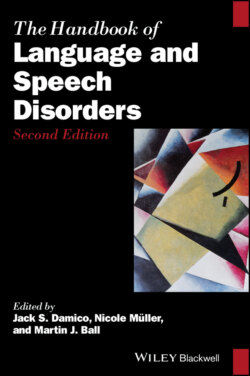Читать книгу The Handbook of Language and Speech Disorders - Группа авторов - Страница 50
3.3.6 Production of Segments
ОглавлениеIt is a plausible assumption that proper speech perception is required for proper speech production. For instance, people with congenital (Osberger & McGarr, 1982) and acquired (Waldstein, 1990) hearing loss tend to produce abnormal speech. The mechanism behind this link has been described in the Directions Into Velocity of Articulators (DIVA) model (Guenther, 2006). In short, during preparation for articulation, an abstract acoustic representation of the target is projected. This projection is compared with the acoustics of the actual projection. Deviations can inform corrections in production online and can also update the representations. The acoustic representations are learned on the basis of speech input accumulated during the speaker’s life. It is therefore to be expected that aberrant input, as in the case of individuals with hearing loss including those who have received a CI, results in aberrant representations and therefore abnormal speech output.
This expectation is corroborated by older as well as more recent work. For instance, in the area of segmental phonetics, CI recipients, in comparison to NH speakers, have been found to have inaccurate consonant (Sundarrajan, Tobey, Nicholas, & Geers, 2019) and vowel (Menard et al., 2007; Verhoeven, Hide, De Maeyer, Gillis, & Gillis, 2016) production; however, see also Baudonck, Van Lierde, Dhooge, and Corthals (2011). Sundarrajan et al. (2019) measured Percentage of Consonants Correct, a metric from Shriberg, Austin, Lewis, McSweeny, and Wilson (1997), and consonant diversity in the spontaneous speech of 129 CI children of around 4 years of age. At the age of 3.5 years, the implanted children’s inventory consisted of 14 consonants and that of the controls of 19, with 17 and 19 for the CI and NH groups, respectively, 1 year later. The CI recipients’ consonant accuracy improved from 71% at 3.5 years to 83% 1 year later, whereas it was 94 and 95% for the controls, at the same ages. Verhoeven et al. (2016) measured the vowel space and dispersion (overlap) in imitations of monosyllables containing the 12 monophthongs of Belgian, by children with conventional HA, children with CIs, and NH children. The HA and CI groups had a more centralized (more so for the second formant, F2, than for the first formant, F1) vowel space, and also more overlap between vowel categories than the control participants. These studies show that the diversity of segmental production in CI users on average is reduced relative to the norm.
